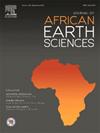东支撞击克拉通后东非裂谷系统在坦桑尼亚克拉通内的延伸机制的适应性
IF 2.2
4区 地球科学
Q2 GEOSCIENCES, MULTIDISCIPLINARY
引用次数: 0
摘要
本文章由计算机程序翻译,如有差异,请以英文原文为准。
Accommodation of the extension regime of the East African rift system within the Tanzania Craton after impingement of the eastern branch on the Craton
Variations in stress regimes within the Tanzania Craton and at the suture between the Pan-African Mozambique Belt (MB) and the Craton are evaluated using stress tensor inversion of focal mechanisms. The change in fault pattern and the difference in earthquake focal mechanisms along these faults as the Eastern branch (EB) of the East African rift system (EARS) crosses into the Craton from MB have also been examined. Results from the stress inversion indicate that as the fault arrays change, when the EB crosses into the Craton, from NNE-SSW in the MB to NE-SW and NW-SE in the Eyasi-Wembere (EWR) and Bahi-KwaMtoro (BKR) regions within and along the Craton boundary, so does the stress pattern. The strain in the area is accommodated primarily by dextral strike-slip faults along NE- and NW-striking faults in EWR and BKR, respectively. The observed coexistence pattern of normal and strike-slip earthquakes in EWR is explained by border fault linkage through transfer faults. The pattern in BKR argues fault linkage through transfer faults where two rift segments, the southern extent of Eyasi and Manyara segments, are linked by an oblique dextral transfer zone. The findings also show that the overall WNW-ESE extension direction introduced by the EARS into the Craton is accommodated by two orthogonal-oriented stresses (Shmin) within the Craton, showing NNW-SSE and ENE-WNW in EWR and BKR, respectively. The different stress orientations in EWR and BKR might be attributed to the resistance exerted by the Craton, leading to restricted deformation along the Craton margin and, in some parts, to lateral delamination of the Craton. The variations in the stress field lead to differences in the fault array as depicted by strain accommodation in normal and strike-slip faults in places like Eyasi-Wembere and Balangida depression in the north and BKR in the south.
求助全文
通过发布文献求助,成功后即可免费获取论文全文。
去求助
来源期刊

Journal of African Earth Sciences
地学-地球科学综合
CiteScore
4.70
自引率
4.30%
发文量
240
审稿时长
12 months
期刊介绍:
The Journal of African Earth Sciences sees itself as the prime geological journal for all aspects of the Earth Sciences about the African plate. Papers dealing with peripheral areas are welcome if they demonstrate a tight link with Africa.
The Journal publishes high quality, peer-reviewed scientific papers. It is devoted primarily to research papers but short communications relating to new developments of broad interest, reviews and book reviews will also be considered. Papers must have international appeal and should present work of more regional than local significance and dealing with well identified and justified scientific questions. Specialised technical papers, analytical or exploration reports must be avoided. Papers on applied geology should preferably be linked to such core disciplines and must be addressed to a more general geoscientific audience.
 求助内容:
求助内容: 应助结果提醒方式:
应助结果提醒方式:


